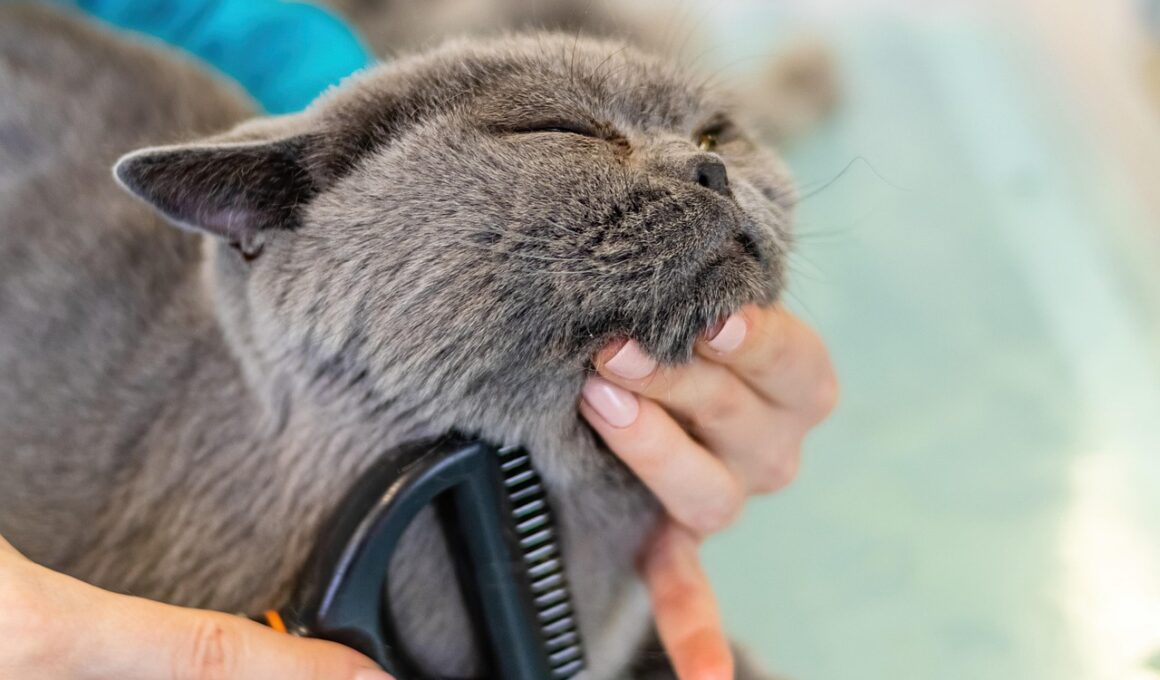Seasonal Grooming Spaces: Setting Up Cat Housing for Shedding Periods
Cat shedding occurs seasonally and can lead to substantial fur accumulation in your living space, necessitating specific adjustments in cat housing. During shedding periods, you need to create a suitable environment that minimizes mess while maximizing comfort for your cat. Setting up a designated grooming space can greatly help with fur management. Ensure that your cat has access to the essentials, such as a comfortable bed, litter box, and fresh water, in this area. Consider placing protective coverings on furniture or using easy-to-clean materials around designated grooming zones. Additionally, incorporating a scratching post can provide mental and physical stimulation, reducing stress during shedding times. You may want to establish a routine for cat grooming, which will involve regular brushing sessions to keep fur at bay. Using tools specifically designed for your cat’s coat type can enhance effectiveness. Effective cleaning methods, such as regularly vacuuming or utilizing lint rollers, are vital during shedding periods. This proactive approach can significantly lessen the burden of dealing with cat hair around your home while keeping your furry friend comfortable throughout the process.
To create an effective atmosphere during shedding periods, considering the lighting, temperature, and ventilation of the cat housing is crucial. Cats are sensitive to temperature fluctuations, so ensuring a comfortable environment for your cat to relax in is essential. You may want to use adjustable heating elements, especially in colder months, to keep the shedding area warm. It’s beneficial to place the grooming space in a spot with plenty of natural light, promoting a cheerful environment. Additionally, ensuring that the space is well-ventilated helps alleviate any discomfort caused by moisture or odor. Circulating air can also reduce allergens created by shedding fur. Consider introducing an air purifier designed to trap pet dander and dust, which can further improve indoor air quality. Regular inspection and reflection on the cleanliness of the internals are also beneficial for maintenance. Create a consistent cleaning routine that helps maintain a neat and orderly space, keeping it inviting for your pet. With proper ventilation, temperature, and brightness, your cat’s seasonal adjustments will lead to effective shedding management.
Choosing the Right Grooming Tools
When addressing seasonal cat shedding, selecting appropriate grooming tools plays a significant role in ease and efficiency. The market provides an array of grooming tools that suit different cat coat types and requirements, thus it’s essential to choose the right ones. For long-haired breeds, look for slicker brushes or combs that effectively detangle knots and mats. On the other hand, short-haired cats may benefit from rubber grooming mitts, which can help to collect loose fur effortlessly. Additionally, consider investing in de-shedding tools known for their effectiveness in reducing shedding by removing dead undercoat fur. Always prioritize comfort for your cat while grooming, ensuring not to irritate their skin. Regular grooming helps trap loose hair, preventing it from scattering around your home. Build a schedule for grooming sessions, as this provides your cat with predictable care. It can also serve as a bonding experience between you and your cat. Proper grooming tools effectively reduce shedding and improve overall coat health, adding an extra layer of value to your regular care routine.
Creating a grooming schedule can have a profound impact on effective shedding management during seasonal changes. Establishing regular brushing sessions not only helps control loose fur but can also significantly benefit your cat’s coat condition. Gauge your cat’s shedding pattern in relation to specific seasons, and use this information to determine how often to groom. For instance, during intense shedding periods, daily brushing may be most beneficial. On lighter shedding days, consider grooming every other day. Engaging your cat with treats and praises during grooming can encourage cooperation and reinforce positive behavior. At the same time, educating yourself about your cat’s specific breed and its grooming needs is vital. Different breeds have distinct requirements, with some needing more frequent care than others. Utilize a stopwatch to track the effectiveness of each session, adjusting the duration and intensity based on your cat’s tolerance. Maintaining a consistent grooming schedule will make managing shedding easier while enhancing your cat’s overall health and happiness.
Building a Comfortable Grooming Space
When establishing a grooming space, comfort for your cat should be a top priority. Cats feel more at ease in environments that reflect their preferences, thus incorporating cozy elements is key. Start by using a soft blanket or a cushioned mat in the designated grooming area, which invites your cat to relax and be comfortable. Position bowls filled with fresh water and a few of their favorite toys nearby to make the space more inviting. While grooming, take care to limit distractions and maintain a calm atmosphere. Use low, soothing sounds to help your cat settle, enhancing their experience. You might also consider utilizing pheromone diffusers designed to promote relaxation for your pet while maintaining tranquility in the grooming area. Installing non-slip surfaces can keep your cat steady during grooming sessions, providing stability and comfort. Keep your tools organized in a separated container within easy reach, removing unnecessary stress during the grooming process. A relaxed and inviting grooming space encourages a positive experience and promotes a collaborative grooming atmosphere.
In addition to creating a helpful grooming environment, communication is vital when managing your cat’s comfort during shedding periods. Cats may exhibit various behaviors while being groomed, indicating their comfort levels; thus, paying attention to their signals is essential. Rewarding your cat with treats for their cooperation promotes a more positive interaction during grooming. Transitioning to deeper grooming strokes can depend on your cat’s comfort; provide breaks if your feline shows signs of stress or discomfort. Use verbal cues and praise to encourage your cat throughout the process, creating an environment of trust and acceptance. Familiarizing your cat with grooming tools prior to sessions can help prevent anxiety. Gradually introduce these items, allowing your cat to explore them in a non-threatening manner. Patience is critical during these encounters, as cats often need time to adapt. Together with gentle handling and the incorporation of reassuring techniques, effective communication can foster smoother grooming sessions. When you attune to both your cat’s needs and behaviors, you create a more enjoyable grooming atmosphere while better addressing shedding concerns.
Cleaning and Maintaining Cat Housing
After grooming and shedding management, keeping your cat housing clean of excess fur is essential. Regular maintenance of the space minimizes allergens and promotes better health for both your cat and family members. Establish a panel of daily cleaning habits, such as vacuuming or sweeping, that can help to manage shedding fur. In addition, utilize lint rollers and pet-specific cleaning products to efficiently remove fur from surfaces. Explore pet-safe air purifiers that eliminate dander, providing cleaner air in your space. Reconsider the cleaning methods applied in general cat areas; for example, washing bedding frequently can greatly decrease fur accumulation. Rotate between various toys as frequent exposure can contribute to fur buildup, keeping their environment dynamic. During shedding seasons, scheduling deep cleaning sessions can be beneficial, while consistently checking furniture for hidden fur is advisable. It’s essential to form these routines into your lifestyle for lasting cleanliness. With proactive measures in place, you create a more hygienic environment conducive for your cat amidst shedding periods.
Lastly, incorporating thoughtful design elements can significantly improve your cat’s seasonal grooming experience. Using various habitats, such as cat trees or shelves, allows your cat to explore and play while having a dedicated space for grooming. Providing vertical spaces vertically engages them and gives your cat more options for their comfort. Ensure that grooming zones are located near paths where your cat typically roams, as it encourages them to visit regularly. Remember to include plenty of hiding spots or cozy nooks, as cats appreciate personal spaces where they can retreat. Utilizing natural elements can enhance the ambiance; for example, incorporating live plants that are safe for cats can brighten their environment. Carefully choose decor that simplifies cleaning, as functional yet appealing designs help create an inviting atmosphere. Designing multifunctional spaces acknowledges your cat’s preferences for privacy while attending to their grooming needs. With these creative touches, you can encourage a positive experience for both you and your feline, significantly aiding in coping with seasonal shedding challenges effectively.


